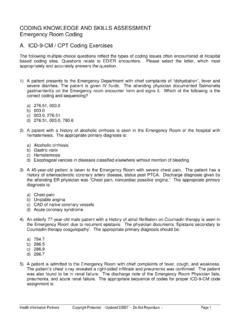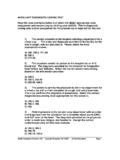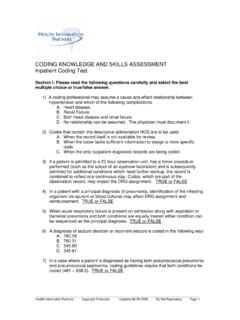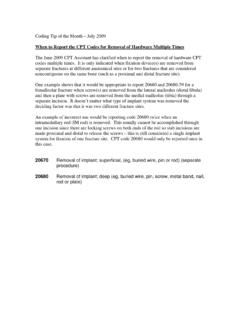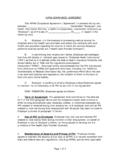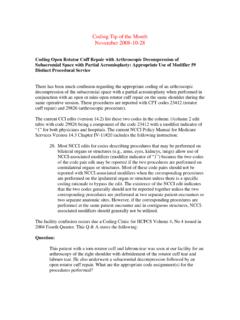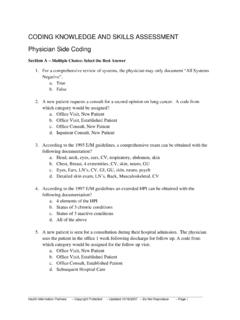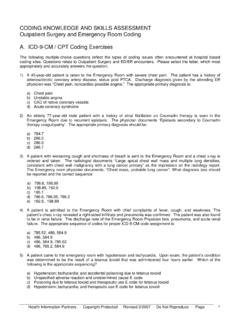Transcription of Coding Tip of the Month May 2009 By: Laurette …
1 Coding Tip of the Month May 2009 By: Laurette pitman , RN, CCS, CPC-H, CGIG Highlight on Upper GI Endoscopy with Ultrasonography The AMA in its recent March 2009 CPT Assistant indicated that there may be issues with appropriate usage of the EGD with ultrasonography codes due to a rapid change in the reporting of these codes. The Coding Communication was issued to clarify the intent of the codes and to aid in reporting. This Month s Coding Tip will discuss these codes. Endoscopic ultrasonography (EUS) combines two types of modalities: endoscopic visualization and high-frequency US. This provides the physician with the ability to image the wall of the GI tract as a series of definable layers rather than as a single entity.
2 It can also provide detailed images of areas in immediate proximity to the GI tract and guide needles precisely through the GI wall into surrounding structures. There are three basic types of echoendoscope designs: a radial array system, a curvilinear array system and high-frequency catheter-based miniprobes. The curvilinear array transducers may also have color Doppler capability. The curvilinear design also makes it possible to direct needle aspiration, biopsies, and fine needle injection under ultrasonographic visualization. The CPT codes for EUS do not distinguish a specific type of instrumentation for Coding . There are multiple indications for EUS in the upper GI tract: 1. evaluation of luminal GI malignancies 2.
3 Evaluation of submucosal abnormalities 3. evaluation of pancreatico-biliary disease 4. evaluation of mediastinal disease 5. evaluation of extraluminal abnormalities identified on other imaging studies 6. therapeutic applications In the outpatient arena, the appropriate diagnosis code would be assigned based on either a definitive diagnosis from the evaluation or if no final diagnosis is made then the presenting signs and symptoms. For the upper GI EUS the physician will perform three basic components for the procedure: the endoscopic examination, the high frequency ultrasound examination and the fine needle aspiration/biopsy if indicated. For these procedures CPT provides six progressive codes to choose from. CPT code 43231 Esophagoscopy, rigid or flexible; with endoscopic ultrasound examination and 43232 Esophagoscopy, rigid or flexible; with transendoscopic ultrasound guided intramural or transmural fine needle aspiration/biopsy(s) are utilized for procedures limited to the esophagus only.
4 These codes are used to describe US examination and FNA of the esophagus and structures adjacent to the esophagus, such as the mediastinum. The next codes related to EUS are 43237 and 43238. These two codes describe procedures in which the endoscopic examination includes the esophagus, stomach, and duodenum or jejunum, but the US and FNA are limited to the esophagus only. Finally codes 43259 and 43242 describe examination of the esophagus, stomach, and duodenum or jejunum by both endoscopic and US methods. Ultrasound examination of structures adjacent to these organs is also included in the reporting. The FNA component of code 43242 can be obtained from any part of the upper GI tract that is evaluated. Paying careful attention to the wording in each code descriptor will prevent inaccurate code assignments.
5 Below is a table excerpted from the March 2009 CPT Assistant which clarifies the elements of each code and is useful in determining code selection for these procedures. Code Endoscopic Component US Component FNA Component 43231 Esophagus Only Esophagus Only None 43232 Esophagus Only Esophagus Only Esophagus Only 43237 Esophagus AND stomach AND either the duodenum and/or jejunum as appropriate Esophagus Only None 43238 Esophagus AND stomach AND either the duodenum and/or jejunum as appropriate Esophagus Only Esophagus Only 43242 Esophagus AND stomach AND either the duodenum and/or jejunum as appropriate Esophagus AND stomach AND either the duodenum and/or jejunum as appropriate Esophagus OR stomach OR duodenum OR jejunum 43259 Esophagus AND
6 Stomach AND either the duodenum and/or jejunum as appropriate Esophagus AND stomach AND either the duodenum and/or jejunum as appropriate None CPT is a registered trademark of the American Medical Association and all codes are copyrighted. Enjoy Spring!
